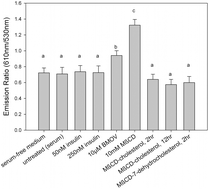The anti-diabetic bis(maltolato)oxovanadium(iv) decreases lipid order while increasing insulin receptor localization in membrane microdomains
Abstract
The effects of treatment with bis(maltolato)oxovanadium(IV) (BMOV) on protein localization in membrane microdomains were investigated by comparing the effects of insulin and treatment with BMOV on the lateral motions and compartmentalization of individual insulin receptors (IR). In addition, effects of insulin and BMOV on the association of IR, phosphorylated IR (pIR) and phosphorylated insulin receptor substrate-1 (pIRS-1) with chemically-isolated plasma membrane microdomains on rat basophilic leukemia (RBL-2H3) cells were evaluated. Single particle tracking experiments indicate that individual quantum dot-labeled IR on RBL-2H3 cells exhibit relatively unrestricted lateral diffusion of approximately 1 × 10−10 cm2 s−1 and are confined in approximately 475 nm diameter cell-surface membrane compartments. After treating of RBL-2H3 cells with 10 μM BMOV, IR lateral diffusion and the size of IR-containing membrane compartments is significantly reduced to 6 × 10−11 cm2 s−1 and approximately 400 nm, respectively. BMOV treatment also increases the association of IR with low-density, detergent-resistant membrane fragments isolated using isopycnic sucrose-gradient centrifugation from 2.4% for untreated cells to 25.8% for cells treated with 10 μM BMOV. Additionally, confocal fluorescence microscopic imaging of live RBL-2H3 cells labeled with the phase sensitive aminonaphthylethenylpyridinium-based dye, Di-4-ANEPPDHQ, indicates that BMOV treatment, but not insulin treatment, decreases cell-surface plasma membrane lipid order while fluorescence correlation spectroscopy measurements suggest that BMOV treatment does not affect IR surface-density or insulin binding affinity. Finally, model studies using microemulsions of cetyltrimethylammonium bromide (CTAB) micelles and 1H NMR spectroscopy show that an oxidized form of BMOV readily localizes near the CTAB head-groups at the lipid–water interface. These observations were supported by IR spectroscopic studies using microemulsions of CTAB reverse micelles showing that both BMOV and oxidized BMOV are associated with the water pool. This conclusion is based on changes in 1H NMR chemical shifts observed for the complex, oxidized BMOV. Moreover, these shifts appeared to be informative about the location of the complex. No differences were observed in the OD absorption peak positions for the CTAB reverse micelles prepared in the presence and absence of BMOV, oxidized BMOV or maltol. Combined, these results suggest that activation of IR signaling by both insulin and BMOV treatment involves increased association of IR with specialized, nanoscale membrane microdomains. The observed insulin-like activity of BMOV or decomposition products of BMOV may be due to changes in cell-surface membrane lipid order rather than due to direct interactions with IR.

- This article is part of the themed collection: Application of Inorganic Chemistry for non-Cancer Therapeutics

 Please wait while we load your content...
Please wait while we load your content...